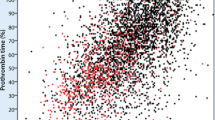Abstract
During eight post-traumatic days, the blood loss and severity of trauma were correlated with the blood levels of lactate, creatinine and catecholamines in 45 patients with multiple blunt injuries. During two days these biochemical indicators correlated with the extent of thoracoabdominal, pelvic and cerebral injuries. In the critically injured patients all three parameters were elevated throughout the observation period. No correlations were observed between plasma catecholamines and lower limb injuries, which seems to make the importance of catecholamines for predicting the onset of fat embolism syndrome less useful.
Similar content being viewed by others
References
Alho, A., Rokkanen, P.: Recovery of patients after intensive care for blunt injuries. Ann. Chir. Gynaec. Fenn. 62, 64 (1973)
Broder, G., Weil, M. H.: Excess lactate: An index of reversibility of shock in human patients. Science 143, 1457 (1964)
Clark, L. C., Thompson, H. L.: Determination of creatine and creatinine in urine. An. Chem. 21, 1218 (1949)
Collins, J. A., Simmons, R. L., James, P. M., Bredenberg, C. E., Anderson, R. W., Heisterkamp, C. A.: Acid-base status of seriously wounded combat casualties. I. Before treatment. Ann. Surg. 171, 595 (1970)
Cowley, R. A., Attar, S., LaBrosse, E., McLaughlin, J., Scanlan, E., Wheeler, S., Hanashiro, P., Grumberg, I., Vitek, V., Mansberger, A.: Some significant biochemical parameters found in 300 shock patients. J. Trauma 9, 926 (1969)
Cushing, H.: Concerning a definite regulatory mechanism of the vasomotor center which controls blood pressure during cerebral compression. Bull. Johns Hopk. Hosp. 12, 290 (1901)
Duff, J. H., Scott, H. M., Perets, D. I., Mulligan, G. W., McLean, L. D.: The diagnosis and treatment of shock in man based on hemodynamic and metabolic measurements. J. Trauma 6, 145 (1966)
Eklund, J.: Studies on renal function in burns. Acta chic. scand. 136, 735 (1970)
Grant, R. T., Reeve, E. B.: Observations of the general effects of injury in man. Memor. med. Res. Coun. (Loud.) Spec. Report Ser. 277, (1951)
Jäättelä, A.: Effects of traumatic shock on plasma catecholamine levels in man. Ann. clin. Res. 4, 204 (1972)
Lepistö, P., Avikainen, V., Alho, A., Jäätelä, A., Karaharju, E., Lahdensuu, M., Rokkanen, P., Tervo, T.: Fat embolism syndrome after severe trauma. Ann. Chir. Gynec. Fenn., in print
Nadler, S. B., Hidalgo, J. U., Bloch, T.: Prediction of blood volume in normal human adults. Surgery 51, 224 (1962)
Rokkanen, P., Alho, A., Lahdensuu, M., Julkunen, H., Kataja, J.: Intensive care of patients with severe blunt injuries. Changing pattern in traumatology. Acta chir. scand. 140, 19 (1974)
Turney, S. Z., LaBrosse, E., Paul, R., Mcaslan, T. C., Dunn, J., Cowley, R. A.: The sympathetic response in head trauma; Catecholamine and cardiopulmonary changes upon alteringPCO2. Ann. Surg. 177, 86 (1973)
Vitek, V., Cowley, R. A.: Blood lactate in the prognosis of various forms of shock. Ann. Surg. 173, 308 (1971)
Author information
Authors and Affiliations
Rights and permissions
About this article
Cite this article
Alho, A., Lahdensuu, M., Jäättelä, A. et al. Biochemical quantification of blunt injuries. Europ. J. Intensive Care Med 1, 61–64 (1975). https://doi.org/10.1007/BF00626427
Issue Date:
DOI: https://doi.org/10.1007/BF00626427




